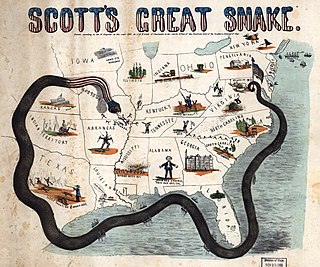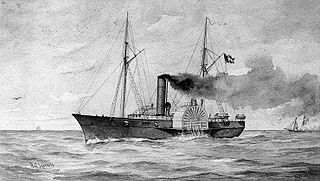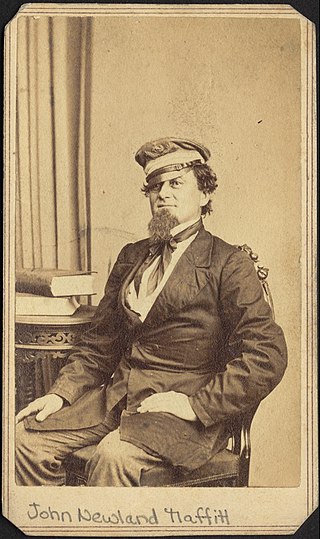
The Anaconda Plan was a strategy outlined by the Union Army for suppressing the Confederacy at the beginning of the American Civil War. Proposed by Union General-in-Chief Winfield Scott, the plan emphasized a Union blockade of the Southern ports and called for an advance down the Mississippi River to cut the South in two. Because the blockade would be rather passive, it was widely derided by a vociferous faction of Union generals who wanted a more vigorous prosecution of the war and likened it to the coils of an anaconda suffocating its victim. The snake image caught on, giving the proposal its popular name.

USS Advance, the second United States Navy ship to be so named, was later known as USS Frolic, and was originally the blockade runner Advance captured by the Union Navy during the latter part of the American Civil War. She was purchased by the Union Navy and outfitted as a gunboat and assigned to the blockade of the waterways of the Confederate States of America. She also served as dispatch ship and supply vessel when military action eventually slowed.
The first USS Sonoma was a sidewheel gunboat that served in the United States Navy during the American Civil War. She was named for Sonoma Creek in northern California, Sonoma County, California, and the town of Sonoma, California, that in turn were named for one of the chiefs of the Chocuyen Indians of that region.

Princess Royal was a British merchant ship and blockade runner that became a cruiser in the Union Navy during the American Civil War and later returned to civilian service.

CSS Nashville was a brig-rigged, side-paddle-wheel passenger steamer that served with the Confederate Navy during the Civil War.

John Newland Maffitt was an officer in the Confederate States Navy who was nicknamed the "Prince of Privateers" due to his success as a blockade runner and commerce raider in the U.S. Civil War.
CSS Raleigh was a steam-powered Civil War casemate ironclad. She was fitted with a spar torpedo instead of an iron ram and was built in 1863–1864 by the Confederate States Navy at Wilmington, North Carolina. While she was being built her commander was Lieutenant John Wilkinson (CSN). She was put into commission on April 30, 1864 under the command of Lieutenant J. Pembroke Jones, CSN.

CSS Robert E. Lee was a fast paddle-steamer, originally built as a Glasgow-Belfast packet boat named Giraffe, which was bought as a blockade runner for the Confederate States during the American Civil War, then subsequently served in the United States Navy as USS Fort Donelson and in the Chilean Navy as Concepción.

The Union blockade in the American Civil War was a naval strategy by the United States to prevent the Confederacy from trading.

USS Santiago de Cuba was a side-wheel steamship acquired by the Union Navy during the first year of the American Civil War. She was outfitted as a gunboat with powerful 20-pounder rifled guns and 32-pounder cannon and was assigned to the Union blockade of the Confederate States of America. She was notably successful in this role, capturing several blockade runners. Her last major action of the war was the assault on Fort Fisher, during which seven of her crew won the Medal of Honor.

USS Huron was a Unadilla-class gunboat built for the United States Navy during the American Civil War for blockage duty against the ports and rivers of the Confederate States of America.

The first USS Dawn was a steam-operated vessel acquired by the Union Navy during the American Civil War. She was used by the Navy to patrol navigable waterways of the Confederacy to prevent the South from trading with other countries.
USS Madgie was a steam gunboat acquired by the Union Navy during the American Civil War. She was used by the Navy to patrol navigable waterways of the Confederacy to prevent the South from trading with other countries.

USS Perry was a brig commissioned by the United States Navy prior to the American Civil War. She was tasked by the Navy for various missions, including those related to diplomatic tensions with Paraguay, the Mexican–American War, the slave trade, and the American Civil War. She was probably named after Commodore Oliver Hazard Perry.

USS Clyde was a paddle steamer captured by the Union Navy during the American Civil War, and commissioned to patrol Florida waters. She had been built in 1861 in Glasgow, Scotland as the Clyde passenger steamer Neptune, but sold in 1863 to become a blockade runner, making two successful round trips to Mobile, Alabama before capture. After the war she was sold to mercantile interests as Indian River, but lost shortly afterwards.
USS Britannia was a steamer captured by the Union Navy during the American Civil War. She was used by the Union Navy as a gunboat and patrol vessel in support of the Union Navy blockade of Confederate waterways.

The first USS Wando was a steamer captured by the Union Navy during the American Civil War. In commission from 1864 to 1865, she was used by the United States Navy as a gunboat in support of the Union Navy blockade of Confederate waterways.

USS Gertrude was the British blockade-running steamship Gertrude captured by the Union Navy during the American Civil War. She was placed in service by the Navy as a gunboat and assigned to patrol the southern coast of the United States for ships attempting to run the Union blockade of Southern ports. She was later the American merchant ship Gussie Telfair until wrecked in 1880.

USS Peterhoff was a British ship captured by the Union Navy during the American Civil War. Condemned as a blockade runner, she served the Union Navy's struggle against the Confederate States of America as a gunboat.

During the American Civil War, blockade runners were used to get supplies through the Union blockade of the Confederate States of America that extended some 3,500 miles (5,600 km) along the Atlantic and Gulf of Mexico coastlines and the lower Mississippi River. The Confederacy had little industrial capability and could not indigenously produce the quantity of arms and other supplies needed to fight against the Union. To meet this need, numerous blockade runners were constructed in the British Isles and were used to import the guns, ordnance and other supplies that the Confederacy desperately needed, in exchange for cotton that the British textile industry needed greatly. To penetrate the blockade, these relatively lightweight shallow draft ships, mostly built in British shipyards and specially designed for speed, but not suited for transporting large quantities of cotton, had to cruise undetected, usually at night, through the Union blockade. The typical blockade runners were privately owned vessels often operating with a letter of marque issued by the Confederate government. If spotted, the blockade runners would attempt to outmaneuver or simply outrun any Union Navy warships on blockade patrol, often successfully.














